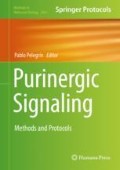Abstract
ATP is one of the main components of the tumor microenvironment, where it affects cell growth, tumor progression and antitumor immune response. The development of the pmeLUC probe, a luciferase engineered to be expressed on the outer facet of the plasma membrane, allowed real-time measurement of extracellular ATP in vitro and in vivo systems, among which the tumor microenvironment. Here we describe the experimental procedures to measure extracellular ATP levels in the tumor microenvironment of three different cancer models generated by the implant of pmeLUC-expressing tumor cells into the appropriate mice strain: ACN human neuroblastoma (nude/nude mice host), WEHI-3B murine leukemia (BALB/c host), and B16F10 murine melanoma (C57Bl/6 host). The procedure to obtain stable expression of pmeLUC in different cell types and methods for the measurement of extracellular ATP with pmeLUC in vitro are also described.
Access this chapter
Tax calculation will be finalised at checkout
Purchases are for personal use only
References
Nath S, Villadsen J (2015) Oxidative phosphorylation revisited. Biotechnol Bioeng 112:429–437
Di Virgilio F, Sarti AC, Falzoni S, De Marchi E, Adinolfi E (2018) Extracellular ATP and P2 purinergic signalling in the tumour microenvironment. Nat Rev Cancer 18:601–618
Burnstock G (2007) Physiology and pathophysiology of purinergic neurotransmission. Physiol Rev 87:659–797
Ozalp VC, Nielsen LJ, Olsen LF (2010) An aptamer-based nanobiosensor for real-time measurements of ATP dynamics. Chembiochem 11:2538–2541
Llaudet E, Hatz S, Droniou M, Dale N (2005) Microelectrode biosensor for real-time measurement of ATP in biological tissue. Anal Chem 77:3267–3273
Berg J, Hung YP, Yellen G (2009) A genetically encoded fluorescent reporter of ATP:ADP ratio. Nat Methods 6:161–166
Dalton CM, Szabadkai G, Carroll J (2014) Measurement of ATP in single oocytes: impact of maturation and cumulus cells on levels and consumption. J Cell Physiol 229:353–361
Manfredi G, Yang L, Gajewski CD, Mattiazzi M (2002) Measurements of ATP in mammalian cells. Methods 26:317–326
Lee DH, Kim SY, Hong JI (2004) A fluorescent pyrophosphate sensor with high selectivity over ATP in water. Angew Chem Int Ed Engl 43:4777–4780
Morciano G, Sarti AC, Marchi S, Missiroli S, Falzoni S, Raffaghello L, Pistoia V, Giorgi C, Di Virgilio F, Pinton P (2017) Use of luciferase probes to measure ATP in living cells and animals. Nat Protoc 12:1542–1562
Di Virgilio F, Pinton P, Falzoni S (2016) Assessing extracellular ATP as danger signal in vivo: the pmeLuc system. Methods Mol Biol 1417:115–129
Pellegatti P, Falzoni S, Pinton P, Rizzuto R, Di Virgilio F (2005) A novel recombinant plasma membrane-targeted luciferase reveals a new pathway for ATP secretion. Mol Biol Cell 16:3659–3665
DeLuca M, McElroy WD (1974) Kinetics of the firefly luciferase catalyzed reactions. Biochemistry 13:921–925
Jouaville LS, Pinton P, Bastianutto C, Rutter GA, Rizzuto R (1999) Regulation of mitochondrial ATP synthesis by calcium: evidence for a long-term metabolic priming. Proc Natl Acad Sci U S A 96:13807–13812
Patergnani S, Baldassari F, De Marchi E, Karkucinska-Wieckowska A, Wieckowski MR, Pinton P (2014) Methods to monitor and compare mitochondrial and glycolytic ATP production. Methods Enzymol 542:313–332
Michels AA, Nguyen VT, Konings AW, Kampinga HH, Bensaude O (1995) Thermostability of a nuclear-targeted luciferase expressed in mammalian cells. Destabilizing influence of the intranuclear microenvironment. Eur J Biochem 234:382–389
Gajewski CD, Yang L, Schon EA, Manfredi G (2003) New insights into the bioenergetics of mitochondrial disorders using intracellular ATP reporters. Mol Biol Cell 14:3628–3635
Pellegatti P, Raffaghello L, Bianchi G, Piccardi F, Pistoia V, Di Virgilio F (2008) Increased level of extracellular ATP at tumor sites: in vivo imaging with plasma membrane luciferase. PLoS One 3:e2599
Michaud M, Martins I, Sukkurwala AQ, Adjemian S, Ma Y, Pellegatti P et al (2011) Autophagy-dependent anticancer immune responses induced by chemotherapeutic agents in mice. Science 334:1573–1577
Bianchi G, Vuerich M, Pellegatti P, Marimpietri D, Emionite L, Marigo I, Bronte V, Di Virgilio F, Pistoia V, Raffaghello L (2014) ATP/P2X7 axis modulates myeloid-derived suppressor cell functions in neuroblastoma microenvironment. Cell Death Dis 5:e1135
Pietrocola F, Pol J, Vacchelli E, Rao S, Enot DP, Baracco EE et al (2016) Caloric restriction Mimetics enhance anticancer immunosurveillance. Cancer Cell 30:147–160
Lecciso M, Ocadlikova D, Sangaletti S, Trabanelli S, De Marchi E, Orioli E et al (2017) ATP release from chemotherapy-treated dying leukemia cells elicits an immune suppressive effect by increasing regulatory T cells and tolerogenic dendritic cells. Front Immunol 8:1918
Acknowledgments
F.D.V. is supported by grants from the Italian Association for Cancer Research (n. IG 13025 and IG 18581), the Ministry of Health of Italy (n. RF-2011-02348435), the Ministry of Education of Italy (n. 20178YTNWC). E.A. is supported by grant from the Italian Association for Cancer Research (n. IG 16812). Both F.D.V. and E.A. are supported by institutional funds from the University of Ferrara. This work was funded with support from the European H2020 office through the COST Action BM1406 “Ion channels and Immune response.”
Author information
Authors and Affiliations
Corresponding author
Editor information
Editors and Affiliations
Rights and permissions
Copyright information
© 2020 Springer Science+Business Media, LLC, part of Springer Nature
About this protocol
Cite this protocol
De Marchi, E., Orioli, E., Pegoraro, A., Adinolfi, E., Di Virgilio, F. (2020). Detection of Extracellular ATP in the Tumor Microenvironment, Using the pmeLUC Biosensor. In: Pelegrín, P. (eds) Purinergic Signaling. Methods in Molecular Biology, vol 2041. Humana, New York, NY. https://doi.org/10.1007/978-1-4939-9717-6_13
Download citation
DOI: https://doi.org/10.1007/978-1-4939-9717-6_13
Published:
Publisher Name: Humana, New York, NY
Print ISBN: 978-1-4939-9716-9
Online ISBN: 978-1-4939-9717-6
eBook Packages: Springer Protocols

